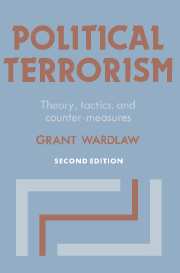Book contents
- Frontmatter
- Contents
- Preface to the second edition
- Preface to the first edition
- Part One An introduction to political terrorism
- 1 The problem of defining terrorism
- 2 Terrorism: a historical perspective
- 3 The changing nature of terrorism
- 4 The purpose of terrorism
- 5 The development of terrorism as a strategy
- 6 Trends in terrorism
- 7 The effects of terrorism
- Part Two Some selected problems in the response to terrorism
- Notes
- Select bibliography
- Index
6 - Trends in terrorism
Published online by Cambridge University Press: 05 January 2012
- Frontmatter
- Contents
- Preface to the second edition
- Preface to the first edition
- Part One An introduction to political terrorism
- 1 The problem of defining terrorism
- 2 Terrorism: a historical perspective
- 3 The changing nature of terrorism
- 4 The purpose of terrorism
- 5 The development of terrorism as a strategy
- 6 Trends in terrorism
- 7 The effects of terrorism
- Part Two Some selected problems in the response to terrorism
- Notes
- Select bibliography
- Index
Summary
One of the consequences of the difficulty of defining terrorism is that it makes the phenomenon very hard to measure accurately. Without a comprehensive and well-accepted definition it is obvious that different measurement attempts will enumerate different incidents or classify them in different ways. In order to attempt to judge the comprehensiveness and validity of any quantitative analysis of terrorism it is, therefore, necessary to study and to accept the definitional premises upon which it is based. Judging the accuracy of the analysis also poses problems because of the difficulty of knowing whether or not all relevant incidents have come to the notice of the analysts. These problems are less critical in the area of international terrorism because the incidents are usually well publicised (and thus easily counted and cross-checked) and fall within widely accepted definitional bounds. However instances of national or domestic terrorism are very hard to measure with an accuracy which would allow great confidence to be placed in trend analyses based upon them.
A recent report by the United States Central Intelligence Agency (CIA) illustrates that even compilation of statistics of international terrorism are fraught with danger. Since 1968, the CIA has kept computerised records on international terrorism. In this context international terrorism is defined as:
The threat or use of violence for political purposes when such action is intended to influence the attitude and behaviour of a target group other than its immediate victims and its ramifications transcend national boundaries.
- Type
- Chapter
- Information
- Political TerrorismTheory, Tactics and Counter-Measures, pp. 50 - 57Publisher: Cambridge University PressPrint publication year: 1989



